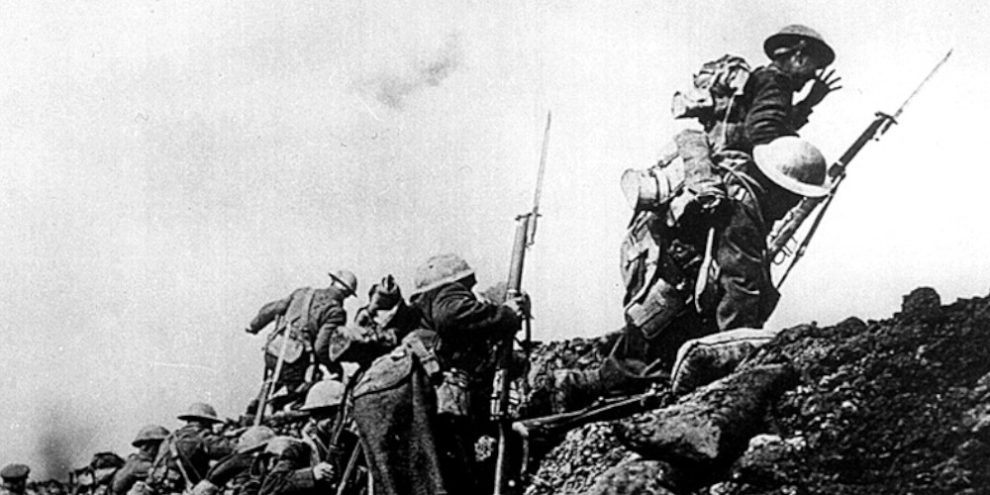
Lasting more than four years, World War I would cause death and destruction on a scale never seen before. More than 650,000 Canadians would serve in the war, with over 172,000 being wounded and 66,000 giving the ultimate sacrifice for their county.
Canadian Wartime efforts in The Great War (as it was known at the time) would help thrust Canada into the international stage and gain worldwide respect as an independent nation.
Here is a small look at some of the biggest battles and contributions of the Canadian forces in World War I.
2nd Battle of Ypres
With French soldiers on their left and British soldiers on their right, Canadian troops would dig in and prepare for their first enemy engagement of the war. Little did they know, the challenge would be even greater than they ever could have ever imagined. Why? The 2nd Battle of Ypres would see the very first use of poison gas as a weapon of war.
German forces released 160 tons of chlorine gas into the wind, which caused the French defence to crumble, leaving a massive 6.5 kilometre gap in the Canadian left flank. After being withered with machine-gun fire, bombarded with artillery shells, and choking through another poison gas attack, all causing terrible losses of nearly one in every three, Canada still held the line.
Battle of the Somme
With the Battle of the Somme lasting over four and a half months, more than 200,000 allied troops losing their lives, and no real major breakthrough occurring, it certainly couldn't be considered a victory for either side. What it did do, however, is continue to push Canada on its path to wartime notoriety as a force to be reckoned with.
During the battle, Canada would use a newly developed tactic called the creeping barrage. Trench warfare had taken a firm grip halfway through the war, and attacking an enemy position was always a guarantee of massive losses. What the creeping barrage did was to have troops follow closely behind a precision artillery bombardment which slowly inched its way forward. This would cause enemy troops to take cover, allowing Canadian troops to move across no man's land without being cut down by the usual overwhelming number of machine gun and rifle fire.
After this battle, Germans began calling Canadian troops "Sturmtruppen" or Stormtroopers, astonished by the bravery and speed of their adversary.
Battle of Vimy Ridge
Probably the most well-known Canadian battle of the war, Vimy Ridge would prove to be another seemingly impossible task Canada was gaining a reputation for completing.
Before 1917, Vimy Ridge was occupied by German forces and every attempt to take it was met with fierce resistance and defeat. When a massive offensive operation was planned by the French and British, Canada was called upon to take this key strategic position.
Canada would not go into this battle unprepared. They created practice trenches and miniature battlegrounds to rehearse the attack, maps were given to each soldier, so each man knew his precise objective and time of arrival, and the creeping barrage would once again be deployed, all of which help push Canadian troops to victory.
The Battle of Passchendaele
Also known as the 3rd Battle of Ypres, Canada would return to the grounds of their first engagement and somehow, this time it would be even more challenging.
With a muddy, flat terrain that offered no cover and slowed movement to a crawl, the area surrounding Passchendaele was a nightmare for troops and the exact opposite of a good offensive position. After the Canadian Corps command was overruled in his attempt to avoid fighting in this area, Canadian troops would make slow and steady progress across the battlefield.
In just four days, Canada would push its way to the outskirts of Passchendaele and within two weeks after that, Canadian forces would squeeze out the last pockets of German resistance from the edge of Passchendaele Ridge.
Related News: World War II: A small look at Canadian contributions
Noticing a pattern? It seems that when a task was so great as to be insurmountable, Canadian forces had earned the reputation as the army to call when failure was not an option. Whether attacking an elevated and heavily guarded position, holding the line while suffering through poison gas, or trudging through deep mud while under a hail of gunfire, Canada would almost never be denied the objective it sought.
It was this reputation that earned them a key place in the Hundred Days Offensive, the final allied push of the war that would cause the German army to surrender and the horrible suffering of World War I to come to a close.
For more information on Canada and its contributions in World War I, click here.
Featured image: Veterans Affair Canada via veterans.gc.ca










